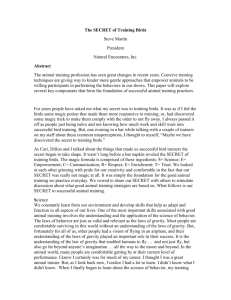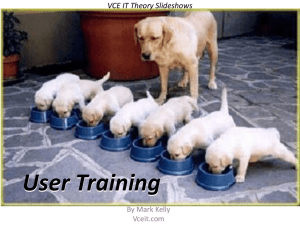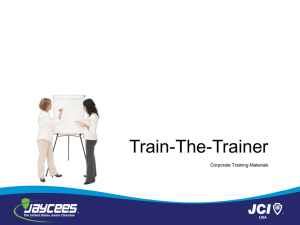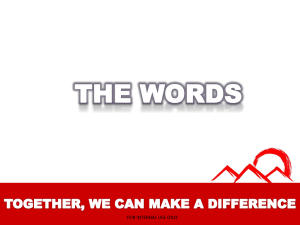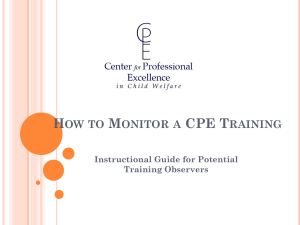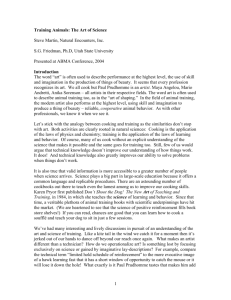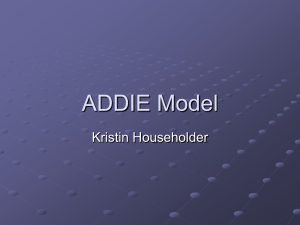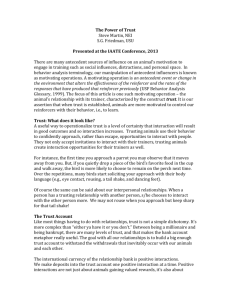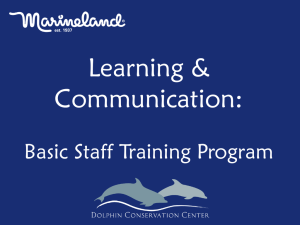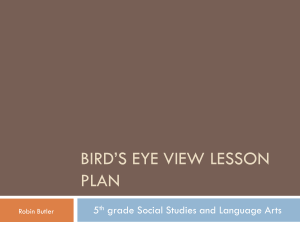Introduction to Raptor Training - The Wildlife Center of Virginia
advertisement
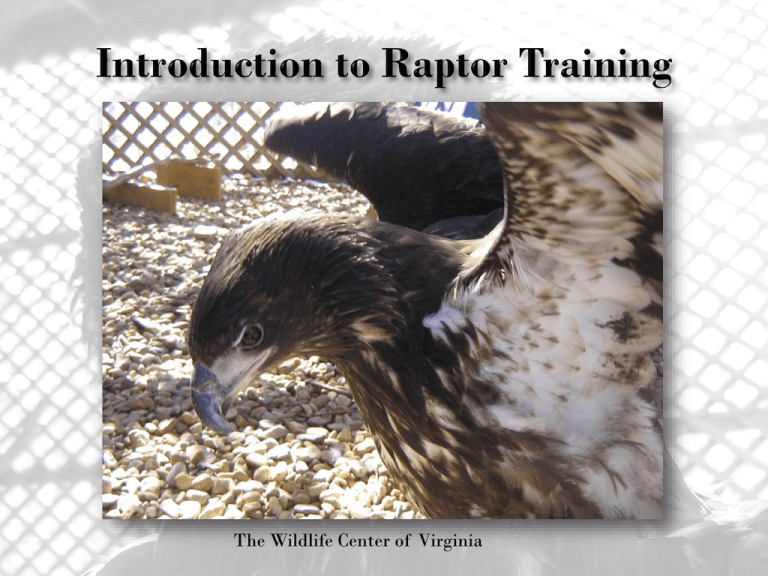
The Wildlife Center of Virginia Education: children and adults gain a connection with animals on a personal level. Engages and inspires them. Enrichment: gets the animal thinking in their environment. Stimulates something new every week and allows them to earn a “living”. Challenges them to make decisions and shape their actions. “Our quality of work is their quality of life.” by Meryle Nelson Relationship: builds a strong relationship with trainer Medical: Health checks on the glove Alymeries – leather anklets around a birds leg. Jesses – leather straps that go through the alymeries with a slit at the bottom. Mostly used for safety and control. Swivel – made of metal with two rings on each end. Jesses are pulled through one end, a leash is pulled through the other. Leash – allows a trainer or educator to safely take a manned bird out of his enclosure without flying away. *All leather equipment is oiled each week to keep clean and soft and more comfortable for the birds. Animals are constantly learning in their environment There are two ways animals learn: Classical Conditioning – train by using a neutral stimulus that brings about a behavioral response. (example: dog, bell and food or clicker). Forms an association between two stimuli. Operant Conditioning – A process of learning in which behaviors are altered by their consequences. They learn to perform or not perform a behavior based on positive/negative reinforcement. Important to remember with this type of training, the animal chooses whether or not they will participate and have the power over their environment. Trainers at the Wildlife Center focus on operant conditioning, where our main goal is to shape the behavior for the desired outcome. Operant Conditioning: ABC’S Antecedents (cues) : Set the occasion for particular behavior (they don’t cause the behavior, they set the stage) Example: Raise your gloved hand to perch near the hawk (command: step up) Behavior is a function of its consequences Consequences (reward) Event that occurs after the behavior that increases a behavior A trainer uses anything to encourage them to do the behavior (visual, audible or gesture). Example: hawk receives food reward Our future behavior – the hawk will continue to step onto glove Reinforcement Anything that increases a behavior Positive reinforcement – increasing a behavior by using a desired stimulus ( kid gets dessert for eating its vegetables) Negative reinforcement – increasing a behavior by using an aversive stimulus. (horse slows down by pulling on reins) •Reinforcing is not absolute…what works for one might not work for the other. Through positive reinforcement the animals motivation will be higher and will be more attentive towards each training session. Punishment Anything that decreases a behavior Positive Punishment – applying an aversive stimulus that decreases a behavior. (you sneeze after petting the dog, so you don’t pet the dog). Negative punishment – is when it loses something it wants due to decreasing behavior. Side effects of positive punishment Increased aggression Loss of interest in the training session Avoidance behavior When trainers start with a behavior, reinforcing the behavior is continuous. Over time, as the behavior is performed 90% of the time trainers will start to reinforce intermittently. When a new behavior is introduced reinforcing is continuous again. *Important in reading and observing the behavior and animal’s hesitation level. Reinforcing intermittently is really important so the behavior doesn’t go extinct. If it is always continuous the behavior has a higher chance of failing. *Element of surprise! Trainers must be careful not to get trapped into mundane sessions. Capturing – catch the animal performing the behavior and reinforce. Quick and simple, but less effective and can bankrupt your relationship. Modeling – watching another animal Bating- used at the beginning of training, but phased out Physically assisting – getting a dog to give you his paw Flooding- surround the animal with aversions to tame it…they learn forced helplessness. Shaping –differentially reinforce by breaking down behaviors into small steps that lead to a final behavior overtime. Give the bird a window of opportunity to perform the desired behavior. This should only be a short period of time. Example: holding your glove up for a long time, the bird will learn that they can take as long as they want and still get a reward. This also occurs in their natural environment. (rabbit went into a hole, snake went under a rock, fish swam away) Individual and natural history of the bird: •Food – Bald Eagles in the wild eat mostly fish as well as rats and small rodents •Social behavior – know the species and the individual. Bald Eagles tend to be more aggressive than other raptors. Footing and biting are defense behaviors. Many raptors put their hackles up when aggressive. Generally it is not advised to train adult bald eagles – high strung and nervous. •Body condition/weight •Habitat – live near large bodies of water. •Injury •Physical limits – Buddy’s beak needs to be coped every month…This partly can affect training. Trainer notices behavioral changes around the time he is coped. What our trainers do •Trainers have a plan with steps to shape the behavior…baby steps lead to the final behavior. Each step needs to be small enough that the bird has a realistic chance of reaching it. •Trainer must be flexible and allow for change •Records are logged for every training session – time/amount of food/description of the session •Every raptor that is in training is worked with everyday the trainer works. •Each trainer has a specific amount of food weighed out in order to train. Motivation Know your bird, so you can figure out what motivates it and what doesn’t -trust with trainer -past experiences -Animal’s confidence -Natural changes – don’t like the rain or wind, etc… -Hunger – this is why it’s important to manage their food. If they are not hungry then food won’t work well as a motivator. Have to figure out the balance so they can perform the behavior. Think in terms of the animals perspective– what is in it for them? Trust – build a strong positive relationship with the bird. Similar to a bank account (Steve Martin). A good trainer gains trust with the bird allowing them to control their environment. Deposits – positive experiences + Withdrawals – negative experiences • A behavior is shaped by experiences Steve Martin describes – the secret to training birds in the word! Science, Empowerment, Communication, Respect, Enrichment, Trust Continued… •Communicate •have confidence • be consistent • have patience, never force the bird to do something it is not ready to do •be elastic •Be observant and read their reactions •Timing is important •Timing: be careful on how fast you train or how slow you train….if they don’t get it back up a step, if they are trained too slowly or not pushing them forward then they will learn to stand still and that makes it harder for them to move to the next step. Example: Rubber Band
